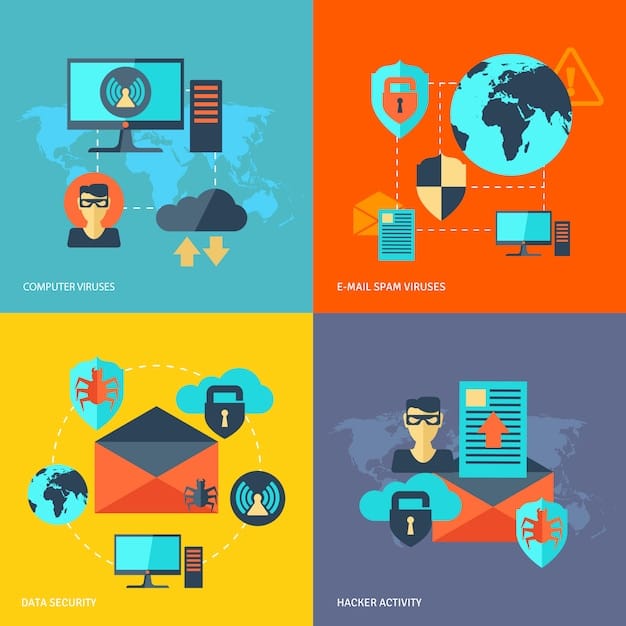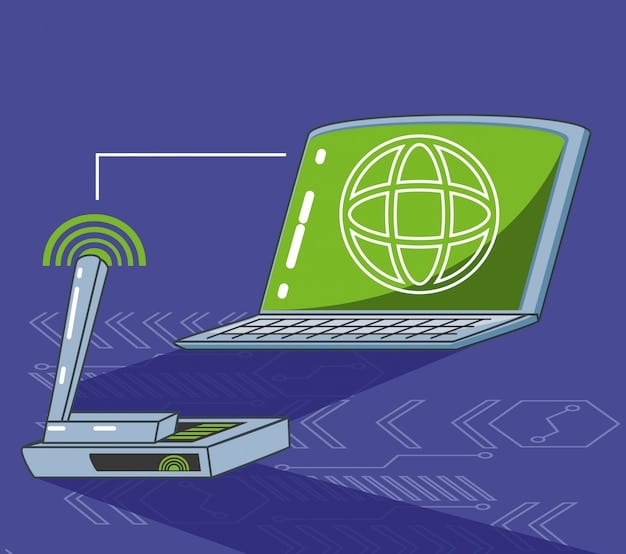Remote Work Security Risks: Secure Your Data in 2025

Remote work security risks are evolving, demanding robust strategies to protect data and prevent breaches; businesses must adopt proactive measures, including threat detection and employee training, to safeguard against sophisticated cyber threats in 2025.
The rise of remote work has brought unparalleled flexibility, but it has also opened new doors for cyber threats. Protecting your data and avoiding costly breaches is more critical than ever. Let’s dive into the remote work security risks you need to be aware of in 2025 and how to mitigate them.
Understanding the Evolving Landscape of Remote Work Security Risks
The landscape of remote work security risks is constantly shifting, primarily due to technological advancements and increasingly sophisticated cyber threats. As more companies embrace remote work, understanding these evolving risks becomes paramount to safeguarding sensitive data and ensuring business continuity. This section provides an overview of the key factors reshaping the security landscape and sets the stage for discussing specific threats and protective measures.
The Shift to Hybrid and Fully Remote Models
The shift to hybrid and fully remote work models has expanded the attack surface for cybercriminals. Employees working outside the traditional office environment often rely on personal devices and unsecured networks, creating vulnerabilities that malicious actors can exploit. Understanding this shift is critical for implementing effective security strategies.
Increasing Sophistication of Cyber Threats
Cyber threats are becoming increasingly sophisticated, with attackers using advanced techniques to bypass traditional security measures. Phishing attacks, ransomware, and malware are evolving to target remote workers specifically, making continuous vigilance and robust security protocols necessary.

The evolving landscape of remote work security demands a proactive approach.
- Endpoint Security: Ensuring all devices accessing corporate networks are secure.
- Network Security: Protecting networks from unauthorized access.
- Data Encryption: Encrypting sensitive data to prevent unauthorized access.
Companies must stay ahead of emerging threats by continuously updating their security measures and training employees to recognize and respond to potential risks.
In conclusion, the evolving landscape of remote work security risks requires a proactive approach, with companies continuously updating their security measures and training employees to recognize and respond to potential risks. By understanding these changes and implementing robust security protocols, organizations can protect their data and ensure the success of their remote work initiatives in 2025.
Common Security Threats Targeting Remote Workers in 2025
In 2025, remote work security risks continue to evolve, presenting unique challenges for organizations. Understanding the common threats targeting remote workers is crucial for implementing effective security measures. This section highlights the prevalent security threats and provides insights into how they can be mitigated.
Phishing and Social Engineering Attacks
Phishing and social engineering attacks remain a top threat, exploiting human vulnerabilities to gain access to sensitive information. Remote workers are particularly vulnerable due to the lack of face-to-face interaction and the increased reliance on digital communication.
Unsecured Home Networks
Many remote workers use unsecured home networks, which lack the robust security measures found in corporate environments. These networks can be easily compromised, providing attackers with access to sensitive data and corporate systems.
Data Breaches and Exfiltration
Data breaches and exfiltration are significant concerns, as remote workers may inadvertently expose sensitive data through unsecured devices, weak passwords, or unencrypted communication channels. Protecting against these breaches requires a multi-layered security approach.

Mitigating these threats requires a comprehensive strategy.
- Security Awareness Training: Educating employees on how to recognize and avoid phishing scams.
- Multi-Factor Authentication (MFA): Implementing MFA to add an extra layer of security to user accounts.
- Virtual Private Networks (VPNs): Using VPNs to encrypt internet traffic and protect sensitive data.
Regularly updating security protocols and providing ongoing training can significantly reduce the risk of successful attacks.
To summarize, common security threats targeting remote workers in 2025 necessitate a comprehensive and proactive security approach. By focusing on employee training, robust authentication methods, and secure network configurations, organizations can effectively mitigate these risks and protect their valuable data assets.
Best Practices for Securing Remote Work Environments
Securing remote work environments requires adopting best practices that protect data, devices, and networks. As remote work security risks continue to grow in sophistication, organizations must implement comprehensive strategies to mitigate these threats. This section outlines the key best practices for ensuring a secure remote work environment.
Implementing Strong Authentication Methods
Strong authentication methods are crucial for verifying the identity of remote workers and preventing unauthorized access to corporate systems. Multi-factor authentication (MFA) and biometric authentication add extra layers of security that significantly reduce the risk of credential theft and unauthorized access.
Securing Home Networks with VPNs and Firewalls
Securing home networks is essential for protecting sensitive data and preventing cyberattacks. Virtual Private Networks (VPNs) encrypt internet traffic, while firewalls block unauthorized access to the network. These tools are fundamental for maintaining a secure remote work environment.
Enforcing Data Encryption and Access Controls
Data encryption and access controls are critical for protecting sensitive information from unauthorized access. Encrypting data both in transit and at rest ensures that it remains protected even if a device is lost or stolen. Access controls limit who can view, modify, or share sensitive data.
A layered approach to security is essential.
- Regular Security Audits: Conducting regular audits to identify and address vulnerabilities.
- Endpoint Protection: Installing and maintaining endpoint protection software on all devices.
- Data Loss Prevention (DLP): Implementing DLP solutions to prevent sensitive data from leaving the corporate network.
By employing these best practices, organizations can create a robust security posture that protects against evolving threats.
In brief, securing remote work environments necessitates a proactive and layered approach, encompassing strong authentication, secure networks, and stringent data protection measures. By implementing these best practices, organizations can effectively mitigate remote work security risks and safeguard their valuable data assets in 2025.
Leveraging Technology to Enhance Remote Work Security
Technology plays a pivotal role in enhancing remote work security risks. By leveraging the right tools and platforms, organizations can create a secure environment for remote workers while maintaining productivity and collaboration. This section explores the key technologies that are essential for securing remote work environments.
Cloud-Based Security Solutions
Cloud-based security solutions offer scalable and flexible protection against a wide range of threats. These solutions can be easily deployed and managed, providing real-time threat detection, incident response, and data protection capabilities.
Endpoint Detection and Response (EDR) Systems
Endpoint Detection and Response (EDR) systems provide advanced threat detection and response capabilities for remote devices. EDR systems monitor endpoint activity, detect suspicious behavior, and automatically respond to security incidents, helping to prevent data breaches and minimize the impact of cyberattacks.
Secure Communication and Collaboration Platforms
Secure communication and collaboration platforms are essential for enabling remote workers to communicate and collaborate securely. These platforms offer end-to-end encryption, access controls, and other security features that protect sensitive information from unauthorized access
Effective technology deployment requires strategic planning.
- Integration with Existing Systems: Ensuring new technologies integrate seamlessly with existing security infrastructure.
- User Training: Providing comprehensive training on how to use security technologies effectively.
- Regular Updates and Patches: Keeping all software and systems up to date with the latest security patches.
By strategically leveraging technology, organizations can significantly enhance their remote work security posture.
In conclusion, leveraging technology is crucial for enhancing remote work security. By adopting cloud-based solutions, EDR systems, and secure communication platforms, organizations can create a robust security environment that protects against evolving threats and supports remote worker productivity. It is critical to integrate these technologies thoughtfully and maintain them vigilantly.
The Human Factor: Training Employees to Recognize and Respond to Threats
The human factor is a critical component of remote work security risks. Even with the most advanced technologies in place, employees can still be the weakest link if they are not properly trained to recognize and respond to threats. This section highlights the importance of employee training and provides practical strategies for creating a security-conscious workforce.
Security Awareness Training Programs
Security awareness training programs are essential for educating employees about the latest cyber threats and best practices for protecting sensitive information. These programs should cover topics such as phishing scams, password security, data handling, and social engineering tactics.
Simulated Phishing Attacks
Simulated phishing attacks are effective for testing employee awareness and identifying areas where additional training is needed. By sending realistic phishing emails to employees, organizations can assess their vulnerability and provide targeted training to those who fall for the scams.
Establishing Clear Security Policies and Procedures
Establishing clear security policies and procedures is crucial for providing employees with guidance on how to handle sensitive data and respond to security incidents. These policies should cover topics such as data classification, access controls, incident reporting, and remote work security best practices.
Continuous reinforcement is key to long-term success.
- Regular Updates: Keeping training materials up to date with the latest threats and best practices.
- Incentives and Recognition: Rewarding employees who demonstrate strong security awareness.
- Feedback and Engagement: Encouraging employees to report suspicious activity and provide feedback on security policies and procedures.
By prioritizing employee training, organizations can significantly reduce the risk of human error and strengthen their overall security posture.
In summary, addressing the human factor through comprehensive training is essential for bolstering remote work security. By implementing effective training programs, conducting simulated phishing attacks, and establishing clear security policies, organizations can empower employees to become a strong line of defense against cyber threats.
Planning for Incident Response and Data Breach Recovery
Effective incident response and data breach recovery plans are critical components of remote work security risks. Even with the best security measures in place, incidents can still occur. Preparing for these events and having a plan in place can minimize the damage and ensure business continuity. This section outlines the key steps for developing a robust incident response and data breach recovery plan.
Developing an Incident Response Plan
An incident response plan should outline the steps to be taken in the event of a security incident. This plan should include procedures for identifying, containing, eradicating, and recovering from incidents.
Data Backup and Recovery Strategies
Data backup and recovery strategies are essential for ensuring that critical data can be restored in the event of a data breach or system failure. Regular backups should be performed and stored securely in a separate location.
Legal and Regulatory Compliance Considerations
Compliance with legal and regulatory requirements is crucial when responding to data breaches. Organizations must understand their obligations under laws such as GDPR, CCPA, and HIPAA, and take steps to comply with these requirements.
Regular testing and refinement are necessary for an effective plan.
- Incident Response Drills: Conducting regular drills to test the effectiveness of the incident response plan.
- Post-Incident Analysis: Performing a thorough analysis after each incident to identify areas for improvement.
- Continuous Monitoring: Monitoring systems and networks for signs of suspicious activity.
By prioritizing incident response and data breach recovery, organizations can mitigate the impact of security incidents and maintain business continuity.
In conclusion, planning for incident response and data breach recovery is a proactive step. Creating and regularly updating an effective plan ensures a swift and controlled reaction to any security incident, further protecting your remote workforce now and in 2025.
| Key Point | Brief Description |
|---|---|
| 🔑 Strong Authentication | Implement MFA to verify user identity. |
| 🛡️ Network Security | Use VPNs to secure home networks. |
| 🧑🏫 Employee Training | Educate staff on phishing and safe practices. |
| 🚨 Incident Response | Plan for quick data breach recovery. |
FAQ
▼
Main risks include phishing attacks, unsecured Wi-Fi, and data breaches due to weak passwords or unencrypted devices. Remote setups lack the in-office security, increasing these vulnerabilities.
▼
Use a strong password for your Wi-Fi, enable a firewall, and use a VPN to encrypt your internet traffic. Keep your router firmware up to date to patch security flaws.
▼
MFA adds extra layers of security by requiring multiple verification methods. It’s crucial because stolen passwords alone won’t grant access, protecting against unauthorized access.
▼
Update your security software as soon as updates are available. Regular updates patch newly discovered vulnerabilities, ensuring your system is protected against the latest threats.
▼
Immediately report it to your IT department or security team. Change your passwords, monitor your accounts for suspicious activity, and follow your company’s incident response protocols.
Conclusion
In conclusion, addressing remote work security risks in 2025 requires a comprehensive approach. By understanding the evolving threat landscape, adopting best practices, and leveraging technology, organizations can create a secure remote work environment that protects data and enables productivity.





